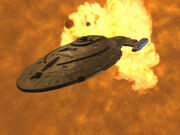
An explosion of metreon particles
A metreon is a particle which can take the form of both radiation and gas. Metreon particles have been demonstrated to react with dark matter, and even to have temporal properties. In their gaseous form, metreon particles are extremely volatile, and are easily ignited via weapons fire.
History[]
Prior to 2153, Vulcan scientists had successfully excited small quantities of dark matter by bombarding the dark matter with metreon particles. In that year, Jonathan Archer, captain of Enterprise NX-01, expanded upon those experiments and, with his science officer, Sub-Commander T'Pol, was able to illuminate a dark matter nebula using spatial charges rigged to spread the particles over a wide area. (ENT: "First Flight")
A year later, while attempting to reach a subspace corridor located in a nebula controlled by the aggressive Kovaalans, Enterprise and a temporally-displaced counterpart entered the nebula above a layer of metreon gas. This had the effect of reflecting the ships' engine signatures, creating multiple sensor ghosts and false readings. This gave the two crews a decisive advantage, initially leading the Kovaalans to believe that the appearance of two Enterprises was simply a result of the reflections. (ENT: "E²")
A dark matter asteroid captured by the USS Discovery in 2257 contained periodic concentrations of metreon particles. A cubic centimeter of the asteroid was estimated to weigh 1.5 metric tons. Sylvia Tilly theorized that the metreon-charged dark matter in the asteroid might be a lead in finding new navigational interface for the spore drive. (DIS: "New Eden")

Rinax, engulfed in a metreon cloud
In 2356, the Haakonian scientist Ma'Bor Jetrel designed a devastating weapon known as the "metreon cascade," to be used against the Talaxians, with whom the Haakonians were at war. The weapon was deployed on the Talaxian moon of Rinax, killing all inhabitants, and leaving Rinax enveloped in a poisonous metreon cloud. Jetrel and others who were exposed to high levels of metreon isotopes developed a fatal blood disorder, which Jetrel came to call "metremia." Fifteen years later, in an attempt to appease his conscience, Jetrel conceived of an idea whereby he could restore the victims of the cascade, in a process to which Jetrel referred as "regenerative fusion." Claiming that the electrostatic properties of the remaining cloud were such that the disassembled biomatter had been held in a state of animated suspension, Jetrel used medical records to identify the genetic coding of a specific victim. He then used the USS Voyager's transporter to target the identified atomic fragments, and attempted to rematerialize him. Jetrel's experiment failed, however, as the degree of fragmentation was too great. (VOY: "Jetrel")

An energy barrier composed of metreon radiation surrounds a planet
In 2371, the USS Olympia, which had been on an extended, long-range exploration of the Beta Quadrant, crashed on a Class L planet surrounded by an exogenic field composed of subspace metreon radiation, which disabled the vessel's engines. The only survivor of the crash was Lisa Cusak, the Olympia's commanding officer. Cusak transmitted a distress signal, but when her subspace radio signal passed through the metreon radiation, it was shifted forward in time three years, where it was picked up by the crew of the USS Defiant. Responding to the distress call, the Defiant crew was able to communicate with Cusak, although neither party realized that a time shift was occurring, until the Defiant arrived at the planet, only to find that Cusak had died three years previously. (DS9: "The Sound of Her Voice")

A Son'a vessel ignites a cloud of metreon gas
In 2375, in a tactic which Lieutenant Commander Geordi La Forge referred to as "the Riker Maneuver," Commander William T. Riker utilized metreon gas to evade two Son'a battle cruisers while in the area of space known as "the Briar Patch." In command of the USS Enterprise-E, Riker ordered the ship's ramscoops utilized to collect as much unstable metreon gas as possible. Upon filling the storage cells to maximum capacity, Riker activated the ship's manual steering column to perform precision maneuvering, and ordered the ramscoops released. Riker then piloted the Enterprise in close proximity to the Son'a ships, leaving a cloud of metreon gas between them and the Enterprise. Subsequent to one of the pursuing vessels firing at the Enterprise, the gas ignited, destroying one of the ships and disabling the other. (Star Trek: Insurrection)

Voyager ignites a metreon cloud
Later that year, in a trap laid by the group of aliens known as "the Think Tank," Voyager became trapped in a cloud of metreon gas upon the explosion of a small planetoid, resulting in the collapse of their warp field and the disabling of their impulse engines. Upon coming under attack by the Hazari, Captain Janeway ordered ship's phasers utilized to ignite the gas cloud, escaping at warp speed as soon as the blast threw Voyager clear of the cloud. (VOY: "Think Tank")
In 2381, the USS Cerritos and the Vulcan cruiser VCF Sh'vhal both detected an anomalous burst of metreon particles from System 7743.8. The particles had originated from the detonation of a Varuvian bomb being "tested" by the Pakled clumpship Pakled. (LD: "wej Duj")
